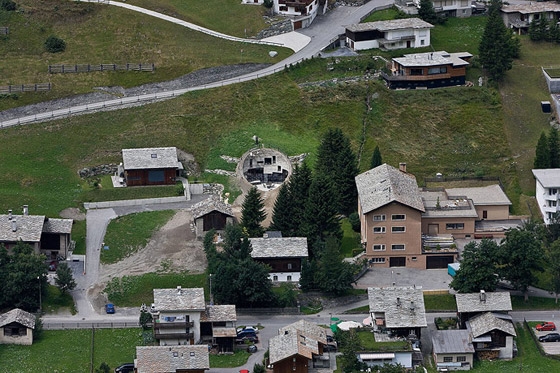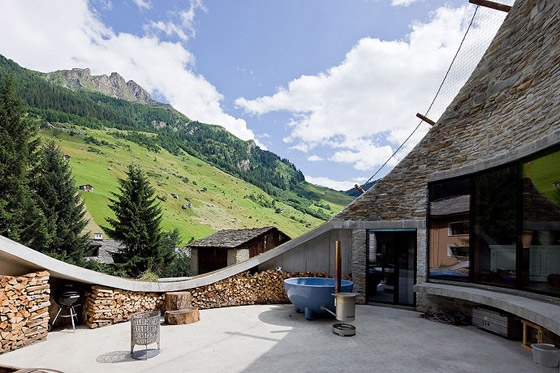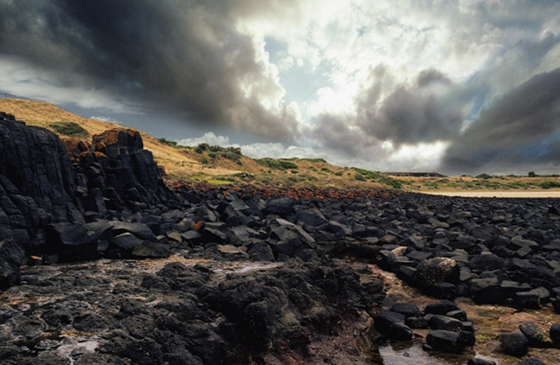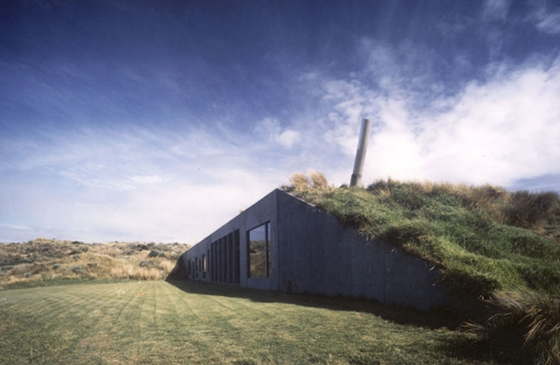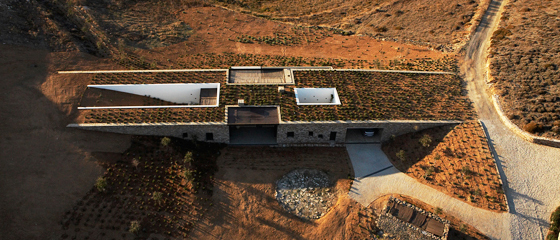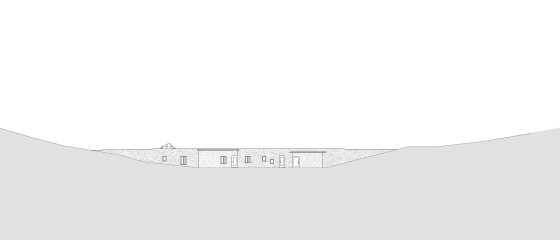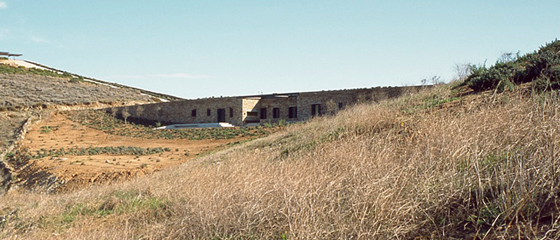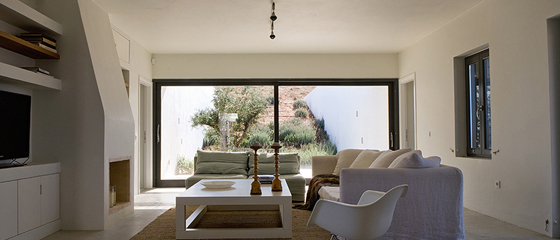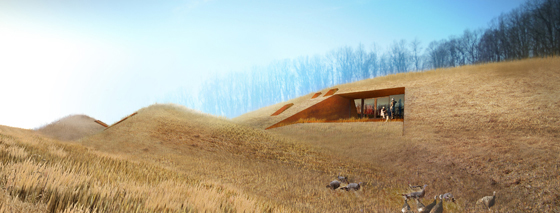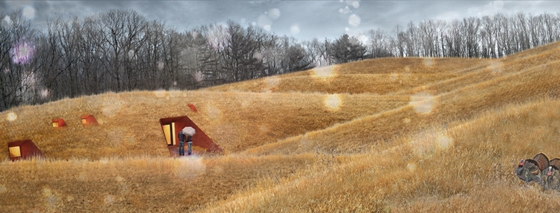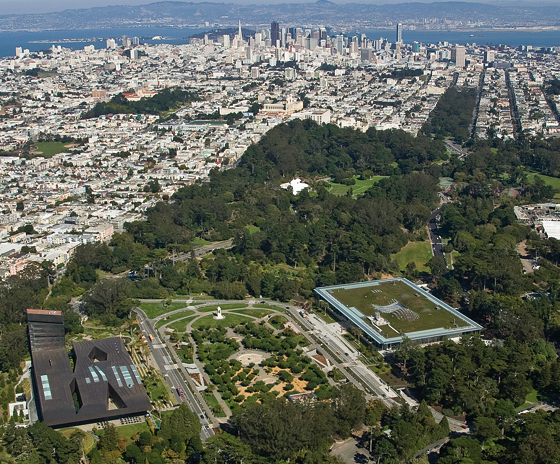Camouflage Architecture: underground buildings
Texte par Susanne Fritz
Suisse
10.06.10
If you're familiar with the Wombles, then you probably encountered underground architecture at any early age. .It's unlikely that the following projects were inspired by the Wombles, but that doesn't mean they're any less successful in terms of their functionality and singularity.
Villa Vals, architecture: SeARCH / Bjarne Mastenbroek i.c.w. CMA, photographer: Iwan Baan
In the Swiss town of Vals, known for its thermal baths, it's not a meteor strike that's created a inverted-dome-shaped hole in the ground: it's a holiday home.
Astonished by the relaxed planning regulations in the vicinity of the baths – an architectural masterpiece by Peter Zumthor – the owner of the house decided on a minimal approach, so as not to obstruct views of the spa complex.
The building embeds itself fully into the landscape, yet offers sufficient natural light and views out onto the picturesque countryside.
Villa Vals, architecture: SeARCH / Bjarne Mastenbroek i.c.w. CMA, photographer: Iwan Baan
Villa Vals, architecture: SeARCH / Bjarne Mastenbroek i.c.w. CMA, photographer: Iwan Baan
Architects Christian Müller and Bjarne Mastenbroeck achieved this by arranging the windows at angles around a circular courtyard. The entrance is perfectly concealed: you arrive across a 'Maiensäss', a typical wooden alpine cabin, and then go through an underground tunnel.
This idea is reminiscent of the 'Fake Chalets' exhibition at the Design Museum in Zurich, which featured photographs of observation bunkers disguised as barns.
Villa Vals, architecture: SeARCH / Bjarne Mastenbroek i.c.w. CMA, photographer: Iwan Baan
Interior of Villa Vals, architecture: SeARCH / Bjarne Mastenbroek i.c.w. CMA, photographer: Iwan Baan

Interior of Villa Vals, architecture: SeARCH / Bjarne Mastenbroek i.c.w. CMA, photographer: Iwan Baan
×The Marshall House by Australian architects Denton Corker Marshall is buried in the dunes of the Melbourne coastline. Looking back from the small bay's beach, it's only visible as a black line; the local rock is of the same hue.
Marshall House, east of Melbourne, architecture: Denton Corker Marshall, © Denton Corker Marshall
Black rocks at the coast, photo © Denton Corker Marshall
The house itself is defined by a wall, which, in turn, marks out a generous, square courtyard, a bit like a sports ground. This north-facing outdoor space offers protection from stormy sea winds and traps the Australian winter sun.
The outer façade of the structure faces towards the sea. Each room's window openings are sized and arranged in such a way that allow picture-like views of the sea.
Marshall House, east of Melbourne, architecture: Denton Corker Marshall, © Denton Corker Marshall
Interior of Marshall House, east of Melbourne, architecture: Denton Corker Marshall, © Denton Corker Marshall

Interior of Marshall House, east of Melbourne, architecture: Denton Corker Marshall, © Denton Corker Marshall
×The Aloni House is located in a similarly rugged coastal landscape, yet in a different hemisphere. The terrain of the Greek Cyclades has been transformed over hundreds of years into a terraced, agricultural landscape. Stone walls prevent erosion and make the cultivation of the steep land easier.
Aloni House, Antiparos island, aerial view, architecture: decaArchitecture, © decaArchitecture
Aloni House, Antiparos island, elevation, architecture: decaArchitecture, © decaArchitecture
The design of the Aloni House took a cue from these existing natural-stone walls. The architectural intervention is located in a hollow between two mountain slopes and creates a bridge, so to speak, between two contours. The house's sides disappear into the ground, blending the structure into the landscape. To the front, the land falls away, allowing one of the house's long elevations a view of the sea. There are five internal courtyards, which flood the rooms with light and shield windows and doors from stormy rainwater.
Aloni House, Antiparos island, architecture: decaArchitecture, © decaArchitecture
Interior of Aloni House, Antiparos island, architecture: decaArchitecture, © decaArchitecture
A whole development of underground homes is due to be built in the conservation area near Frank Lloyd Wright's famous Fallingwater house in Pennsylvania. Patkau Architects won a competition run by the Western Pennsylvania Conservancy, an institute that looks after the preservation and maintenance of Fallingwater.
Cottages at Fallingwater (USA), architecture: Patkau Architects, rendering © Patkau Architects
The six new units will serve as accommodation for participants in the institute's further-education programme.
The jury praised the subtle, yet progressive, character of the design, with its minimal impact on the landscape, which also met the criteria of sustainability and energy efficiency that had been set down.
Cottages at Fallingwater (USA), architecture: Patkau Architects, rendering © Patkau Architects
Model of Cottages at Fallingwater (USA), architecture: Patkau Architects, photo © Patkau Architects
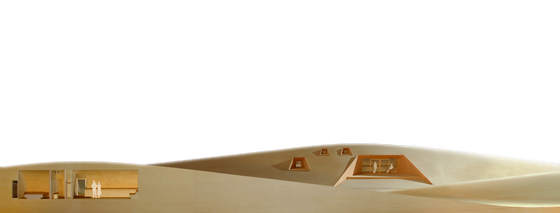
Model of Cottages at Fallingwater (USA), architecture: Patkau Architects, photo © Patkau Architects
×Interior of Cottages at Fallingwater (USA), architecture: Patkau Architects, rendering © Patkau Architects
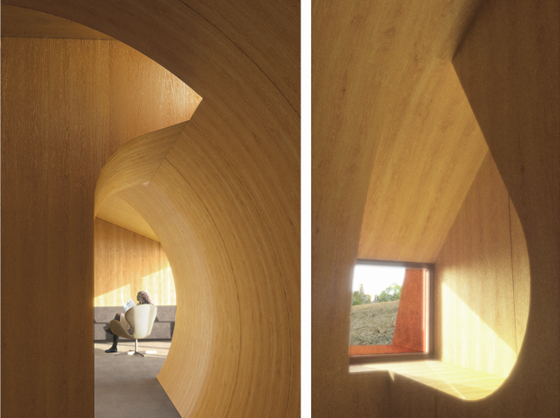
Interior of Cottages at Fallingwater (USA), architecture: Patkau Architects, rendering © Patkau Architects
×The California Academy of Sciences is the last and also the biggest of the projects discussed here; it is less subterranean than the others, but just as integrated into its physical context.
Most notable about Renzo Piano's California Academy of Sciences is its 'roofscape'. The academy brings together research, natural-science collections, teaching and public exhibitions under one roof, and houses an aquarium, a planetarium and a rainforest biosphere. These three building elements represent outer space, Earth and the oceans, and function as the three 'columns' that support the roof and form the roofscape's three hills.
Aerial view of the Goldengate Park, San Francisco, photographer: Tom Fox, SWA Group
Made of rock, the aquarium alone, which is open to visitors, can house 38,000 species from all over the planet.
The institute's scientific collection, which belongs to the research department, contains 18 million specimens in jars and other special containers. With its mission 'To Explore, Explain and Protect the Natural World', the academy's design programme was always destined to be a sustainable one. Apart from the building's energy-saving features, valuable consideration was given to the choice of materials and to the re-using of building elements from the old academy.
Californian Academy of Sciences, photographer: Ishida Shunji © Rpbw, Renzo Piano Building Workshop
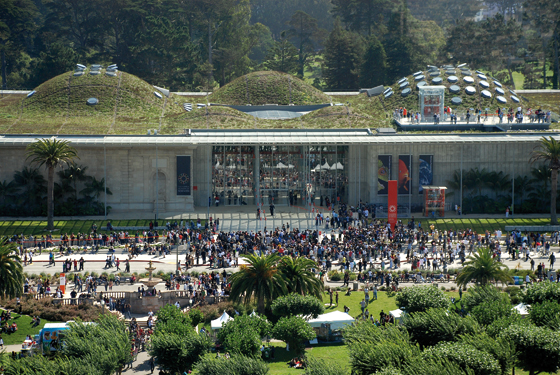
Californian Academy of Sciences, photographer: Ishida Shunji © Rpbw, Renzo Piano Building Workshop
×The structure's insulation consists in part of recycled denim jeans, and the roof not only gives a bit of nature back, but also functions to stop heat escaping. In the middle of the roofscape, over the interior piazza, is a large, glazed skylight; lots of smaller, hole-like skylights are dotted across the roof, offering natural daylight and opening automatically to give the interiors natural ventilation.
Californian Academy of Sciences, view of roof, photographer: Mc Neal Jon © Rpbw, Renzo Piano Building Workshop
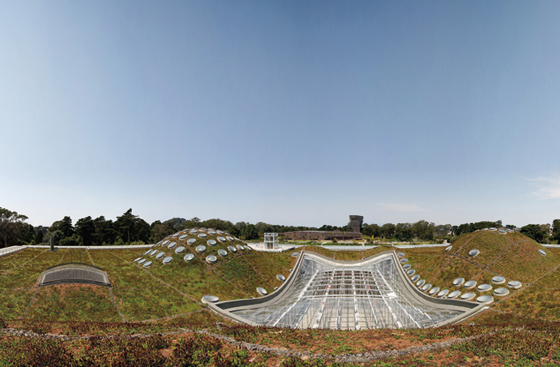
Californian Academy of Sciences, view of roof, photographer: Mc Neal Jon © Rpbw, Renzo Piano Building Workshop
×Skylights in the roof allow sunlight to reach the living rainforest and coral reef. They also open automatically to allow heat to escape, photographer: Justine Lee © Rpbw, Renzo Piano Building Workshop
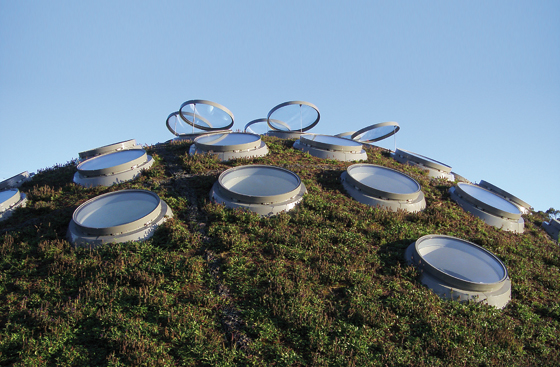
Skylights in the roof allow sunlight to reach the living rainforest and coral reef. They also open automatically to allow heat to escape, photographer: Justine Lee © Rpbw, Renzo Piano Building Workshop
×Conceptual sketch of the Piazza, photographer: Goldberg Stefano - Publifoto © Rpbw, Renzo Piano Building Workshop
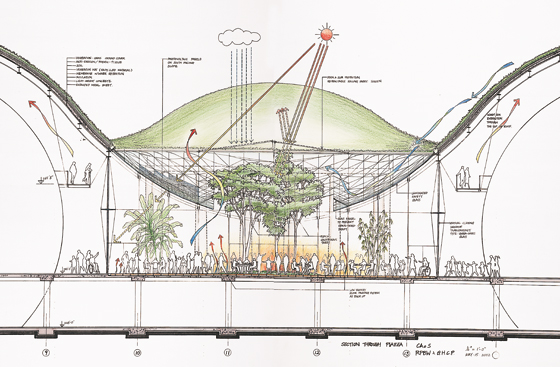
Conceptual sketch of the Piazza, photographer: Goldberg Stefano - Publifoto © Rpbw, Renzo Piano Building Workshop
×The green roof stretches all the way to the outer walls, where it meets a glass canopy containing over 55,000 solar-energy cells. The roof's substructure consists of a combination of concrete and steel framework. A water-retentive layer is built into the roof structure. The rest of the building is realised in light-grey exposed concrete (including the African Hall, whose original rendering in limestone was reused); the moulding holes were left open to allow for the fixing of exhibits.
View of the exhibit hall of the Californian Academy of Sciences, view to the West, Photographer: Nic Lehoux © Rpbw, Renzo Piano Building Workshop
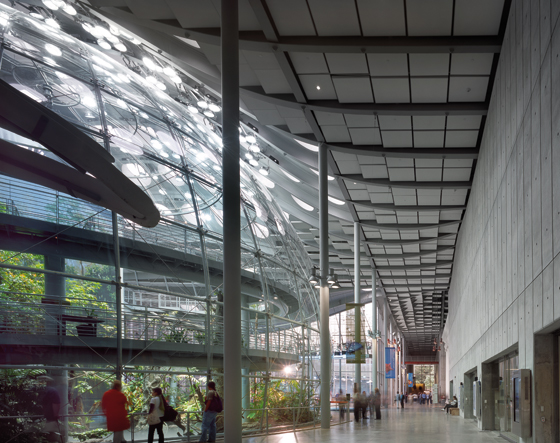
View of the exhibit hall of the Californian Academy of Sciences, view to the West, Photographer: Nic Lehoux © Rpbw, Renzo Piano Building Workshop
×The Wombles knew the advantages of subterranean building, in harmony with nature and making full use of recycled materials. So forget Le Corbusier's charters, the books of Vitruvius, and other manifestos. Instead, let's sing together the words of the Wombles' (almost architecturally modern) theme tune:
Underground, overground, wombling free
The Wombles of Wimbledon Common are we
Making good use of the things that we find
Things that the everyday folks leave behind...
